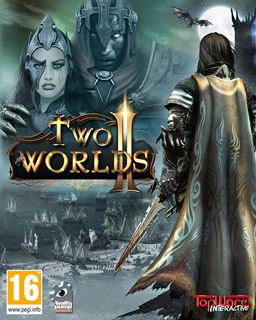![]()
When Reality Pump released Two Worlds in the fall of 2007, the game was noted by many critics as an ambitious game that fell flat due to its overwhelmingly unpolished and glitch-ridden delivery. My experience with the game was very similar. Coming fresh from the gameplay offered in the 2006 release The Elder Scrolls 4: Oblivion, I had high hopes that Two Worlds would continue to satisfy my RPG needs. Sadly, I returned the game shortly after first starting it up.
In many ways, Two Worlds 2 is the same as its predecessor in terms of shortcomings, but it does offer up some interesting aspects that will grab RPG fans’ interest.
 Two Worlds 2
Two Worlds 2
Platform: Microsoft Windows, Mac OS X, OnLive, PlayStation 3, Xbox 360
Developer: Reality Pump
Publisher: Topware Interactive
$59.00
The Story
The game takes place five years after the events of the first game. The hero and his sister, Kyra, are being held captive by an evil mage named Gandohar in his castle. In the opening cut scenes, Gandohar unveils his plan to use Kyra to extract some kind of old magic power that could rule all of Antaloor. He does this in an almost classic super villain manner, and after exposing his full plan, he orders a few guards to imprison the hero forever and ever. Shortly after being taken away though, the hero is freed by a band of orcs and teleported to their home base. It is here that he meets a scantily clad prophet named Cassara, who makes herself out to be Gandohar’s mortal enemy. Motivated by hopes of getting his sister back, the hero joins the prophet and her clan of orcs to take out the evil mage before he can seize power. Queue epic music.
From that point on, you don’t really see much of the orc bunch. As the hero, you are teleported to a small Saharan town with a vague “get to this city” type quest. It is here that you are also bombarded by a steady stream of side-quests. Though initially overwhelming, I found these quests to be a redeeming feature of the game because of their variety and interesting storylines.
The most unfortunate part about any of the stories in the game is that they’re primarily dialogue driven. This wouldn’t be a big deal (Oblivion and many other RPG’s are the same way), but the dialogue is just bad. The hero only speaks in a low/monotone voice and repeats much of what he says throughout the game (you’ll hear him say “fair enough” in almost every dialogue instance), and the other character’s dialogues are just as bad. Toss in the fact that almost every conversation instance is too long winded and you’ll be happy that Reality Pump added in the “skip dialogue” button.
Gameplay
From a graphical standpoint, Two Worlds 2 looks good; the towns and cities are surprisingly detailed and the world of Antaloor boasts a wide variety of landscapes to explore. The world is plagued by glitches though, npc’s, small objects like barrels and crates, and enemies will appear out of nowhere. This can be very annoying when you’re traveling via horse, and are suddenly “stopped” by a roadblock that has yet to render, and are attacked by a tribe of Vern (the anthropomorphic wolf-people of Antaloor. The character animations are also mediocre at best. This is most evident in the combat animations, which were sluggish and simplistic, and in the almost non-existent facial animations of characters during conversations (to make up for this npc’s flail their arms around to show emotion).

The actually difficulty of the game varied wildly. This was partially due to the context-based control scheme, which placed “sprint,” “sneak,” and “zoom” all on the same trigger. This poses problems, especially if you want to fight with the bow (where you need to be able to continually fire and run away). The sheer number of enemies thrown at you at any given moment also contributed to the game’s difficulty. I found that one or two enemies at a time were manageable on the easy setting, but more often than not, the game would throw six to twelve. This forced me to slowly chip at enemy groups, pulling one away to kill at a time. This could only be done at certain times though, when you’re in a confined area such as a cave or temple and multiple enemies are running towards you, the only choice is to run lest you get killed near instantly. Thankfully, avoiding enemies is easy, and because enemy npc’s were so slow and simple-minded (get more than a few feet away and they will forget you are there) running away became my main strategy.

One redeeming aspect of the gameplay though is most definitely the forging and magic systems. Most every armor piece or weapon in the game can be broken down and used to fortify and upgrade other weapons; this system also allows you to add elemental effects to weapons and armor. The magic system is card based and allows you to add multiple cards to a spell that can modify anything from the elemental effect(s) to whether the spell is shot or has an area effect.
Verdict
The main story does pick up as you progress through the world, but it’s predictable and unsatisfying. Two Worlds 2 earns two and a half stars. Even though Reality Pump managed to create a visually pleasing game with a rich forging system, they failed to correct many of the issues that plagued the first game.




2 Comments
I was really looking forward to this but more for the multiplayer. There is supposed to be an online village you can create that develops based on your playstyle and will be different than a village your friends have. So your village may excel in crafting bladed weapons while your friends village focuses on armor. The idea of an online community that had to rely on each other was pretty enticing tome. But I have yet to hear anyone mention this feature, either good or bad, in a review. That makes me think the online component is mainly a throw away mode.
I’ve always thought “Two Worlds” was a pretty bland name. “Two Worlds 2” somehow manages to top that.